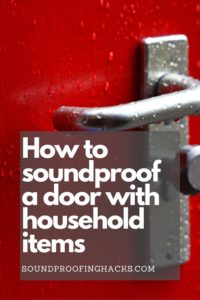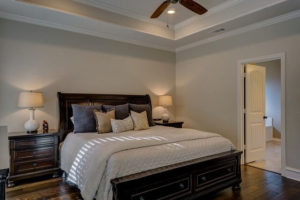How to soundproof a door with household items?
Recently I had a friend come over my place and he commented that he wants to start some home improvement projects during the weekend. So he asked for my advice, and naturally I asked him to start with a soundproofing setup.

To get him started off quickly and easily, I wanted to suggest something that he do do within a couple of hours and make use of things he can find at home.
Another criteria was to soundproof a door, which often is a trouble spot since they are typically hollow.
This means that he won’t need a financial outlay to start out in home improvement and at the same time, he gets to recycle stuff!
Did you know that the world produces 3.5 million tons of plastic waste each day? We can all do our bit in saving precious resources.
If you want to know how to soundproof a door with household items, read on to find out how!
I am an Amazon Affiliate, which means I may make a commission if you purchase something through the links here. There is NO extra cost to you at all, and THANK YOU so much for the support.
Related: How to stop wind from blowing down chimney: 3 simple steps you can follow right now
Contents: Skip to section
Why you should soundproof your doors?
The reasons behind people needing to sound-proof their doors are numerous; wild housemates, noisy children and loud animals to name a few. People will focus on windows and walls when looking for the ‘breech’ or entry point of noise pollution rather than considering their doors – most houses will have hollow-core internal doors (honey comb framework inside) which are cheap and so a popular option, with housing developers, to install inside properties.

Sound-proofing internal doors can be a solution to a permanent problem, or a temporary issue, and so there are different solutions that are going to be better for each individuals’ circumstances. Some are more expensive than others depending on what level of ‘sound-proof’ you want; which depend so on the level of noise you need to mute out.
Understandably the people who are most effected by loud noises coming through the door and even the gaps around it are people who work night-shifts who aren’t likely to appreciate being woken up by a blender first thing by their housemate or people working remotely who are trying to shut off from distracting family. It could be as simple as wanting to block out the temporary droning of some building work that your neighbor is having done.
Related: How to quiet a pool pump: 3 easy steps to start today!
Methods to soundproof a door with household items
Hollow to the core! You need something solid
The best solution to sound-proofing your house is to install solid-core doors but because they are made of woodchip and resin, and then put under intense hydraulic pressure to make it sturdy.
However, they do come with an expensive price tag and so this is not often a feasible option for the average renter or homeowner.
So, while this is AN option, there are some alternatives that can help first.
Related: How to soundproof a room for drums: Turn it into a reality now!
Let the curtain fall!
Tale as old as time, but reliable. Hanging fabrics to cover and seal the door helps by providing an additional layer to the door to absorb the sounds and mute them from being heard. The thicker the better; curtains, heavy drapes or thick woolen blankets, any of these would be great.
We recommend that you avoid using thinner fabrics like linen etc.; You could layer the fabrics to create a similar desired thickness and layering these fabrics can give a luxe-look to the doorway; but it does create more effort for you upon entering the room and it will certainly not be as successful at sound-proofing the door as some thicker fabrics would be.
As a temporary solution you can fix the fabric into place using strong tape or shutting the fabric in the top of the door. For a long-term solution we recommend using a hanging rod above the doorway – you will need tools and fixings (hammer, nail, screwdriver & screw). Make sure you measure the height of the door so that you know how long a drop you need in your fabric so the curtains fall right to the ground; like the ones below.
Related: Soundskins vs Dynamat: Battle of the sound deadeners
Get snug with a rug
This method is simple, fixings free, and is particularly useful for people who have hardwood, tiled or laminated flooring.
Mainly because these types of flooring are perfect for creating loud and echoing environments where sound (like the pitter-patter of dog paws on the floor) can bounce under the gap in the door and then around an entire room or house.
Placing a rug, or matt, directly in front of the door will absorb the sound coming through the door to help to mute its volume.
If you have carpet already, well, all the better because just as with the curtains or drapes, the key here to muffling and reducing the noise pollution coming into the room through the door is thickness.
Adding a rug on top will only help the situation further, Victorian (we’ve linked a keenly priced one!) and Oriental rugs would make a great choice for this but any rug with this sort of density will do the trick.
Oh, best worth saying – the only real limit with thickness is make sure that you can open your door clearly of the rug without it getting trapped, or caught, otherwise it will cause a hazard and become a bit of a nuisance.
Related: How to soundproof an apartment door
Tape it up
Okay, this solution is the one I had in mind when I was saying some of these weren’t going to be pretty. And this isn’t my first recommendation for a reason but if you have cracks and splits in the doors that are preventing you from blocking out the noise then this method will help you in a pinch.
The only tools for this you need is scissors to make sure you cut your tape to the best size.
The ideal would be duct tape from the shed, as opposed to stationary sellotape, but if that is all you have to hand then layering the tape (several or so) should replicate the thickness and desired effect of the duct tape.
Cut the tape into sections suitable to cover the slit, keeping the tape taut so that there are not rolls or gaps.
To optimize the effectiveness of the taping then you need to make sure you have taped any slits or cracks on both sides of the door for complete sound-proofing.
Because the internal of a hollow-core door has often got a honeycomb frame-work of large void spaces with some support wood so preventing the sound getting in there directly will only help.
Related: How to Soundproof Barn Doors in 9 Practical Ways
Paint it all over
This is such a simple method to sound-proof a hollow-core door. A thick, gloss, based paint would best but any paint that you have will do the job because the trick here is layers. Layers of paint are your friend! (contrary to the enemy layers of unwanted paint can be when you are trying to remove them…go figure).
You will need at least three, to four, coats of paint to achieve the desired sound-proofing if you use a thick paint.
If you have thinner paint then you will likely need a few more coats to make any difference in terms of sound-proofing so go ahead and paint several layers on there.
The initial layers will fill gaps, cracks and splits in the wood and then additional layers just help create more for the acoustics to have to go through.
Obviously, the paint also has a double benefit as it helps freshen up a door with a new look (perhaps cover any tape you may have put in place because there isn’t really any harm in doing a double, or triple, up of these methods).
Related: Does Soundproof Paint Work? Facts You Should Know
Door/Weather Seals
Door seals double up as weatherproofing measures as well as being handy for sound proofing because they reduce the volume and echo of sounds.
You will need a bit of DIY to fit these as most require to either be nailed, or screwed, into place. There are glue and magnetic alternatives but these can be less effective.
Door seals are inexpensive and can be bought from most department stores; we’ve linked something ideal you here.
Open/closed foams
I debated on whether to include this solution or not – but it is one, so I have. The debate came from the finer detail that depending on what foam you choose to use and your property, there is a chance it can be considered a fire-risk and so it isn’t something I recommend lightly and definitely recommend really exploring if this is right for you and checking with the relevant people on where you stand legally.
If everything with the foam is safe and legal – it is super easy to install. Just measure the width and height of your door to see the amount you need (open foam is suitable for absorbing sound but you will need closed foam to block it) and fix it into place using adhesive glue (we have linked one with adhesive below to show how simple it can be). The installation is very simple and straightforward so you will be sound-proofed within the hour.
Related: 5 Best Quiet Treadmills for your Home
Frequently Asked Questions (FAQ)
What is sound-proofing?
Sound-proofing is reducing or muting unwanted noise – the amount of noise that you are looking to mute is going to directly relate to the steps and measures that you take to reduce that.
Can I use egg cartons to sound-proof my door?
Now might be a good time to confirm that although egg-cartons seem to get praised for their soundproofing qualities (here’s looking at you home recording studios) because they look like sound-proofing acoustic foam but for us in terms of an effective house-hold sound-proof item they are at the bottom of the list. as a sound-proofing measure.
While they reduce echo to a degree, they mainly manipulate the sound and do little to actually block it. So, sorry if you’ve tried that before you saw this.
What materials can I use to soundproof?
Some materials we have already explored are open & closed foams but curtains and drapes are best in nylon, or woolen fabrics.
Another one of my favorites is using moving blankets, mainly because they are cheap and very effective. If you don’t wish to purchase one, try to look for old blankets to do the job instead.
Certain materials are better layered whilst others are fine to stand alone.
How to soundproof a door with household items: Conclusion
Once you have learned about the kinds of material that are effective in soundproofing, it is down to your creativity how you wish to use household items to perform soundproofing projects.
Not only can you treat you doors, but there are several other areas in your home that can be improved acoustically.
I have written lots of soundproofing tips that you can check out in this blog, and if you have any suggestions or ideas to share, please leave a comment down below!
All related links:
- How to stop wind from blowing down chimney: 3 simple steps you can follow right now
- How to quiet a pool pump: 3 easy steps to start today!
- How to soundproof a room for drums: Turn it into a reality now!
- Soundskins vs Dynamat: Battle of the sound deadeners
- How to Soundproof Barn Doors in 9 Practical Ways
- Does Soundproof Paint Work? Facts You Should Know
- 5 Best Quiet Treadmills for your Home
Additional resources:
- How much does it cost to soundproof a room: Smart ways to save money
- How to reduce road noise in your car: 5 trouble spots to look at
- How to make air conditioner quieter? 6 simple tips that work!
- How to make a fish tank quieter in 3 simple steps
- 9 Best Acoustic Partitions: How to choose the right one
- All buying guides and reviews





